On 14 July, we had a lovely evening sail under Genoa up the inside passage of the Raiatea reef, to Uturoa Town dock, where we were berthed between Beverley an Australian lady , and Harry a colourful South African now Australian with his crew Audrey on Malua. They all came over to dinner on Kika a subsequent evening and Beverly brought home made Sushi for starters .
 |
| Beverly and the Sushi Starters (a good name for a pop group!) |
 |
| The town quay, Uturoa. |
 |
| Looking down from the mountains to the lagoon and the crashing waves over the reef. |
The reefs are formed outside the islands by the deposition of coral. Fresh water run off from the mountains then carves out deep channels, between the outside of the reef and the land. The water only exits at a few places known as passes which accounts for the constant outflow of water through the passes. Interestingly French Polynesia sits between two tidal systems with very little moon tide as a result. Sun tide then comes into play, so the best time to approach a pass is at midday when tidal flow will be less and the sun directly overhead will show up those treacherous patches of coral. Dark blue means deep water, light blue shallower, and white very shallow where the sun reflects directly off the white calcified coral.
 |
| Church spire on Tahaa. Bora Bora in the distance. |
The channels inside the reefs have been well buoyed by the French, and make beautiful calm sailing. There is no swell as all the waves break on the outside reef , with a constant roar so you can cruise around in lovely sunshine without even having your Gin and Tonic shaken. The shallow areas of live coral are of course a haven for every form of marine life imaginable which makes these coral islands a Mecca for snorkelling and diving.
 |
| Difficult to see ahead at times! |
We dined out at a small creperie run by two French speaking Belgians Patrick and his wife Patrice . Their little van was parked in a romantic spot on the waters edge. Patrick had put fairy lighting under the awning and you could sit at tables watching the sun go down , listening to the gentle sound of a French chantreuse, while eating a delicious crepe, washed down with an ice cream. Only the French really understand how to create ambience from very little.
 |
| The biggest decision of the day...coconut? or is it mango ice cream? |
Staying at the town dock was great. There was a very good internet cafe within 20 yards, and just across the road there was a vibrant vegetable market. On the morning of 15 July there was great excitement there as the people of Uttoroa welcomed a delegation of Polynesians from Hawaii, celebrating the migation of the Polynesian people accross the seas. On one side of the square a lively band revved it up and on the other side there was a beautiful construction of a ship made from local plants and flowers. On top of the ship a young man in traditional dress blew his conch shell, to be answered by a different note from a conch shell blown from the band across the square. They sound like soft foghorns which is why they were used at sea to communicate.
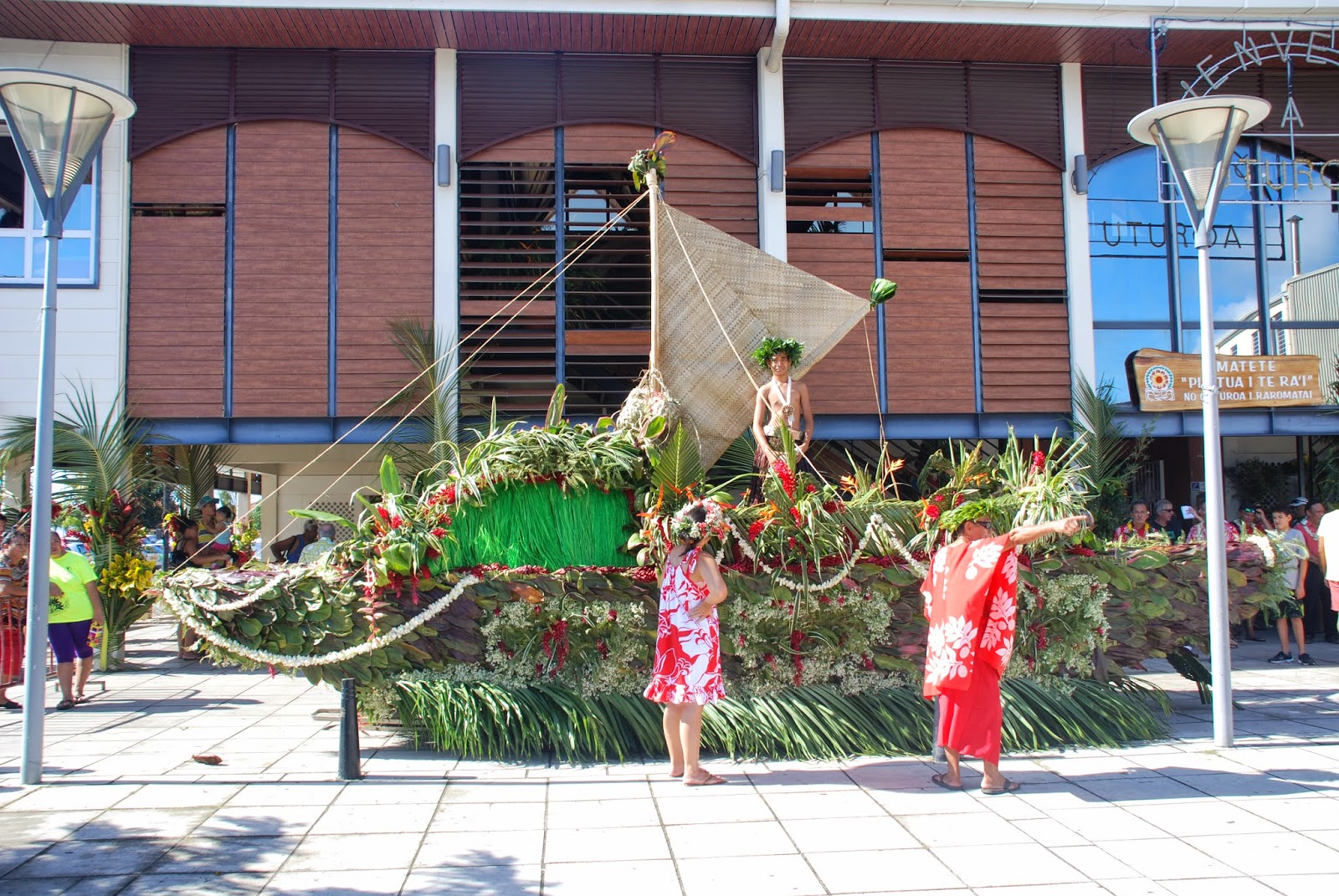 |
| Floating the boat! |
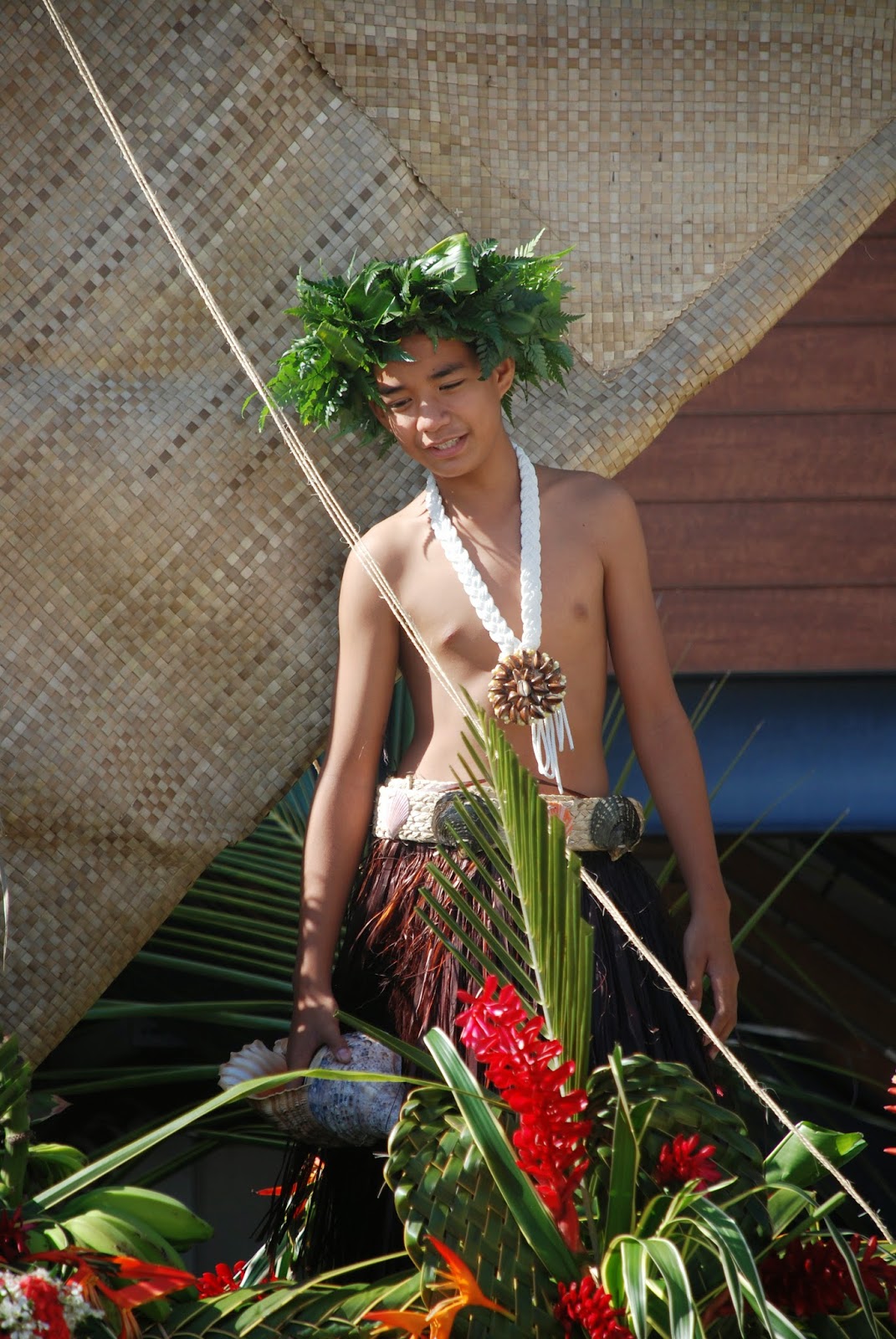 |
| Boy with Conche |
After a lively display of dancing and singing , in which everybody joined in at the end ; we repaired to the market where there was free tasting of local fruits and vegetables. The lady mayor of Uturoa, a friendly jolly woman wearing a traditional outfit, introduced us to everything on offer. What a great way to welcome people to your town!,
 |
| The mayor and her sister.... |
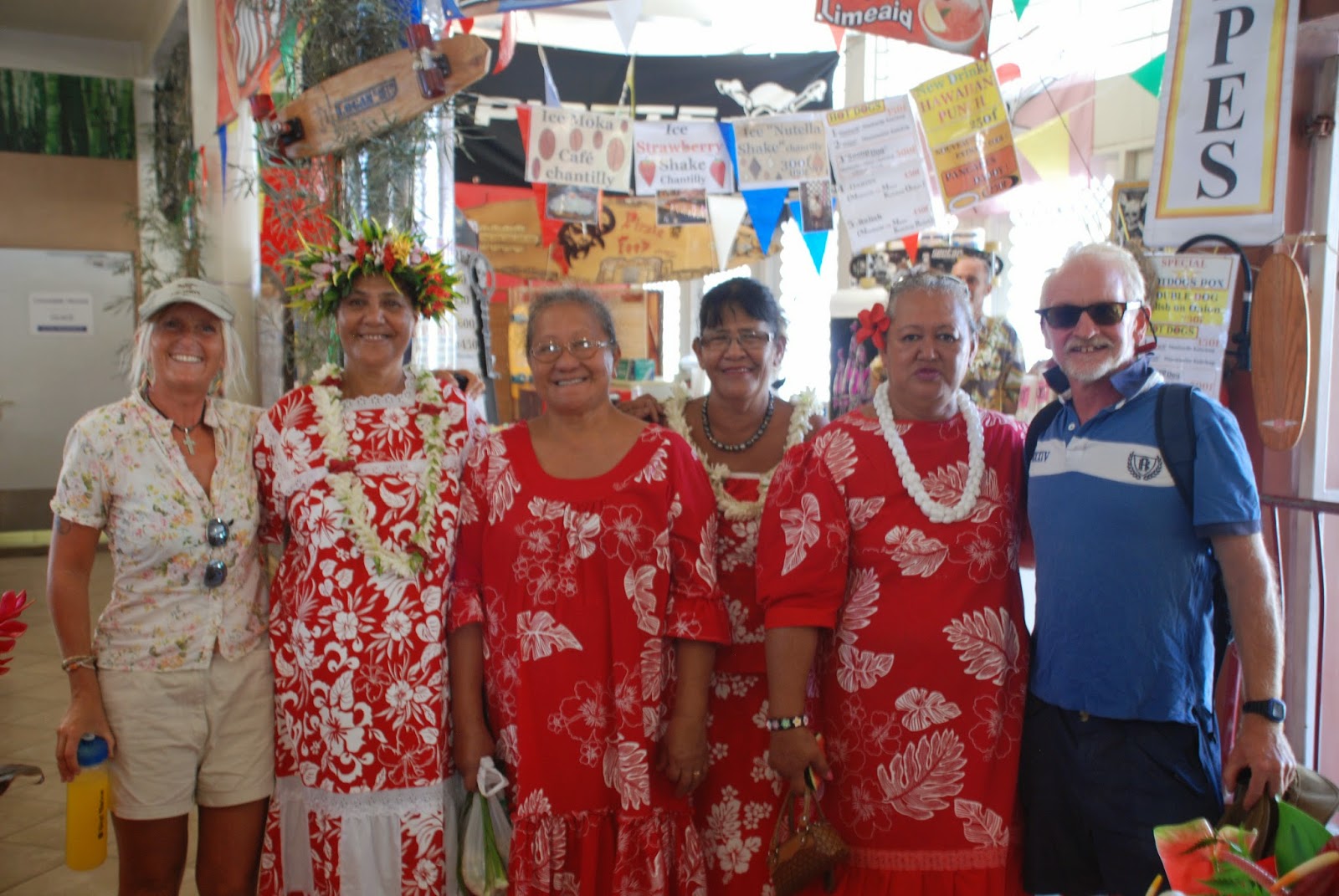 |
| and other VIP's welcome Kika |
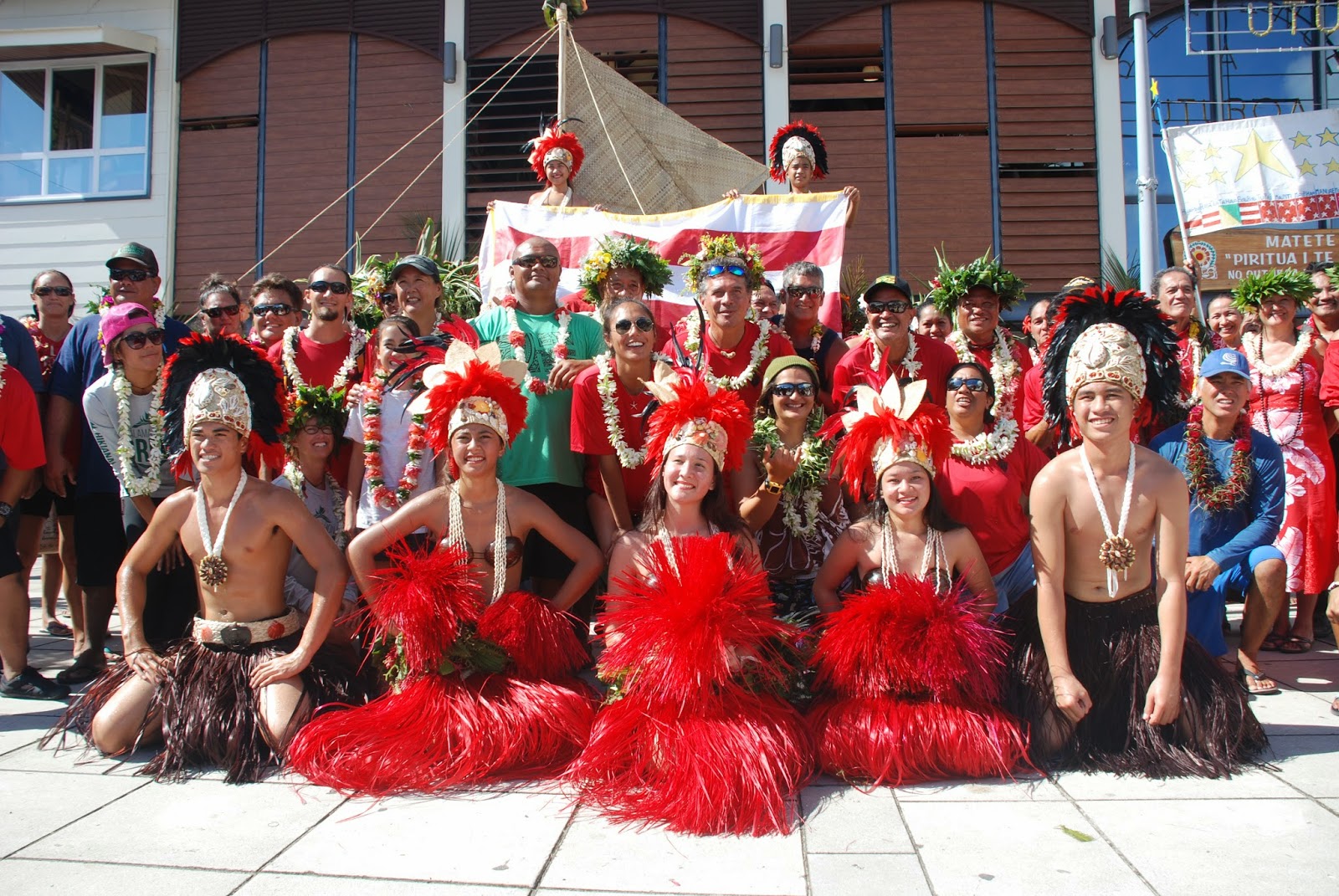 |
| Locals put on a bit of a show to celebrate the arrival of Kika's crew and those canoes from Hawii |
While we were in Uturoa, we climbed the small mountain behind the town and were rewarded with a magnificent view of the two islands of Raiatea and Tahaa. You could see the buoyed passage between them. Bora Bora was framed by the late afternoon sun in the distance
 |
| Our view from Raiatea. Tahaa to the right and Bora Bora in the distance |
Colin and Sally went diving together with Harry, Audrey and Dave from sailing vessel Elena, on the only diveable wreck of The French Polynesia Islands. I wimped out because of my shoulder and went snorkeling, but they got down to 29 metres and explored the whole wreck. Bowsprit, Anchor ,mast and an airpocket which you could surface in and breathe fairly foul air. Colin did well as a relatively novice diver to manage a wreck at 30 metres.
 |
| Sally and Audrey. Dive buddies and good friends |
We turned up in the evening for the local Heiva festival in the big tent.
Our friend the Lady Mayor welcomed and thanked everyone in Tahitian and French without any notes and went on to explain this years theme, which was scenes from the island. The event was rather like a Welsh Eisteddfod, with dancing and singing from children's groups, a mums group some of whom looked like they needed the exercise. There was one lady rushing around the mums group doing up their grass skirts as they moved, to prevent them dropping to the floor as they wiggled their hips. The whole community were having a great time.
On Friday 18 July we sailed 8 miles up the beautiful inside passage to Tahaa, the island on top of Raiatea. We anchored in Harapiti bay, and got a bit of a fright as we drifted back on the anchor which was in 20 metres of water; the back of the keel touched a large shelf of coral which seemed to come from nowhere. Fortunately there was no damage done and we re anchored nearer the centre of the bay.
 |
| Our view from Harapiti bay. Bora Bora in the setting sun. |
The skipper was also bailed out by the first mate the next morning. While resplicing the end of the dinghy painter, I omited to attach it properly as I went below for some scissors. Result one dinghy floating slowly away. Colin immediately stripped off and dived in towing a large dinghy back, with the painter between his teeth- what a star!
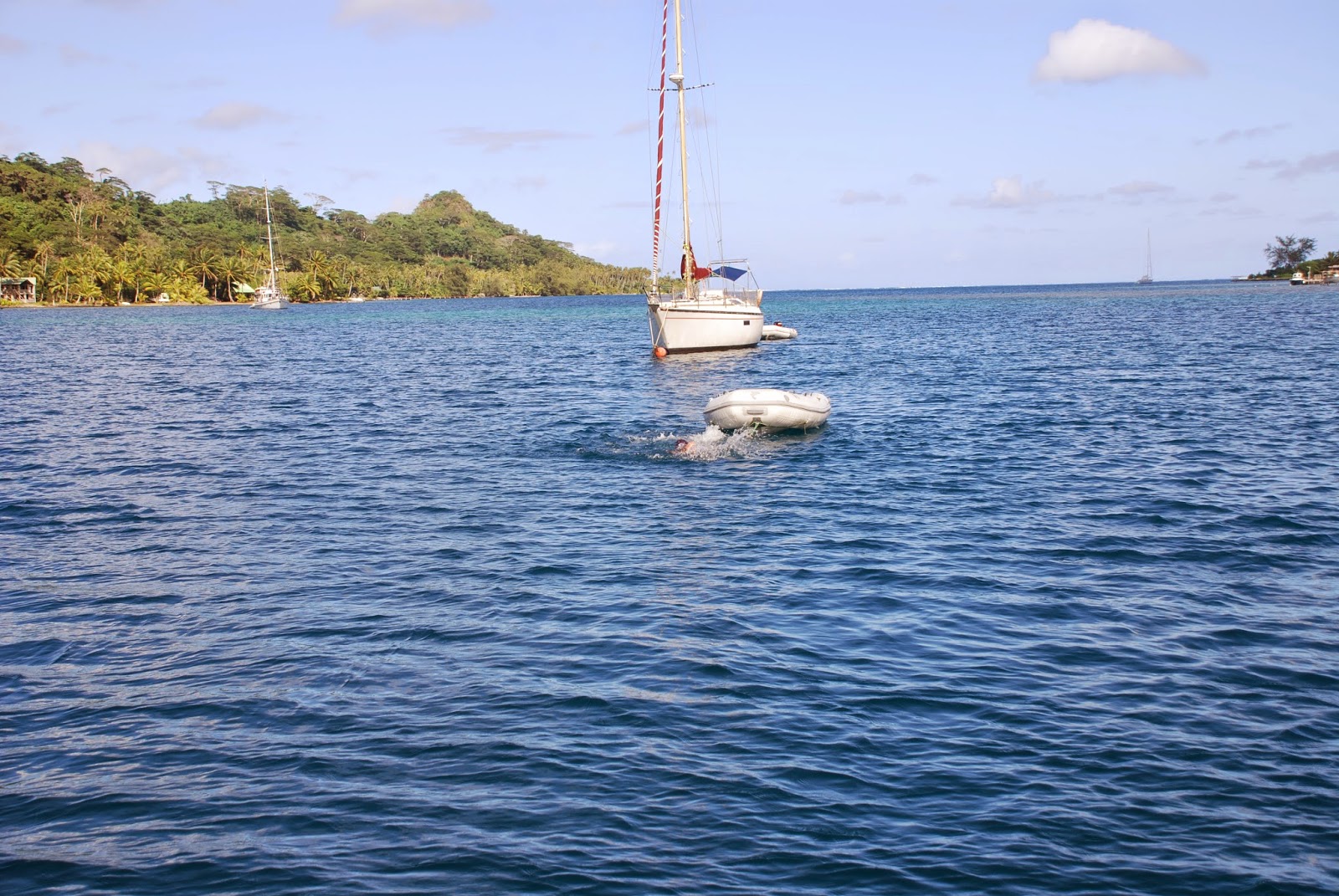 |
| Dingy with new outboard engine! |
On Saturday 19th July we anchored off a place between two islands called the coral gardens. We dinghied ashore , took a path under the coconuts and then dropped into the water flowing between the two islands to drift snorkel down on the current. Just beneath the surface grew every kind of coral immagineable, from staghorn fronds to sea anemones with beautiful wavy clam shells with bright blue speckled interiors opening and closing. Numerous species of fish abounded with the smaller ones hiding between the fronds of the coral as one approached. Lurking in the shadows were Lion fish, moray eels and the odd octopus extending his tentacles towards the unwary. It was like a stroll through the most exotic garden imaginable with the vivid colours and variety of the fish quite stunning. Needless to say we did the drift 2 or three times .
Overnight, the wind got up. We didn't drift but there were grinding noises from the anchor chain. All was revealed the next day when the anchor appeared stuck fast. We tried motoring off in different directions to no avail. We were about to enlist the help of our friends Dave and Kate from Elena who had diving gear when Colin managed to free dive 20 metres with his snorkel gear to get a good look at the anchor and chain. (He was the underwater diving champion at school, and his training regime as a very small boy was seeing how long he could hold his breath under the water in the bath, much to the alarm of his poor mother). The chain had ground a groove in a large boulder or bommie of coral . Colin reckoned that if we let out more slack and motored in a particular direction we could free it and lo and behold it came clear. Just shows the value of direct observation of what's going on beneath the surface. The chain looked a bit shiny where it had ground off the galvanising at twenty metres, but was otherwise OK.
We cruised up the lagoon to look at a windy anchorage off the town of Patio at the North of the island, however after last nights experience we didn't fancy it, and sailed down in the late afternoon to protected Tapamau bay and a couple of large gin and tonics before dinner.
 |
| On the way to Patio.... Tahaa church spire and a distant Bora Bora. |
On Monday 21 July, we had a lovely day sail over to Bora Bora. The wind was 15-20 knots on the beam and Kika eat up the 27 mile passage at a good 6 knots. We anchored off the Bora Bora Yacht Club next to a couple of super yachts in very deep water, 25 metres, (60 fathoms) letting out all our 50 metres of chain and another 15 metres of rope to give us enough scope. Bora Bora is a spectacular island centred around a massive peak that can be seen from 50 miles out to sea. As a result it is a favourite honeymoon destination with prices to match. The Bora Bora Yacht club was no exception , first of all telling us they were fully booked for dinner, and then that we could eat straight away. When we saw the super yacht prices we politely declined, in favour of marinated
fried tuna on Kika.
We found our crowd of scruffy peasants, the cruisers who never pay for anything parked round the corner in the next bay. The anchorage there was also an improvement. The Maikai yacht club was friendly and informal and it was good to catch up with all the gossip from our friends in other boats.
 |
| Maikai Yacht Club |
Ashore we hitch hiked to the North of the Island and hiked over a mountain ridge to the other side of the island. At the top of the hill lived an artist who painted scenes in surrealist vivid colours. His claim to fame was selling a picture to Pierce Brosnan( James Bond) who looked very happy with his purchase.
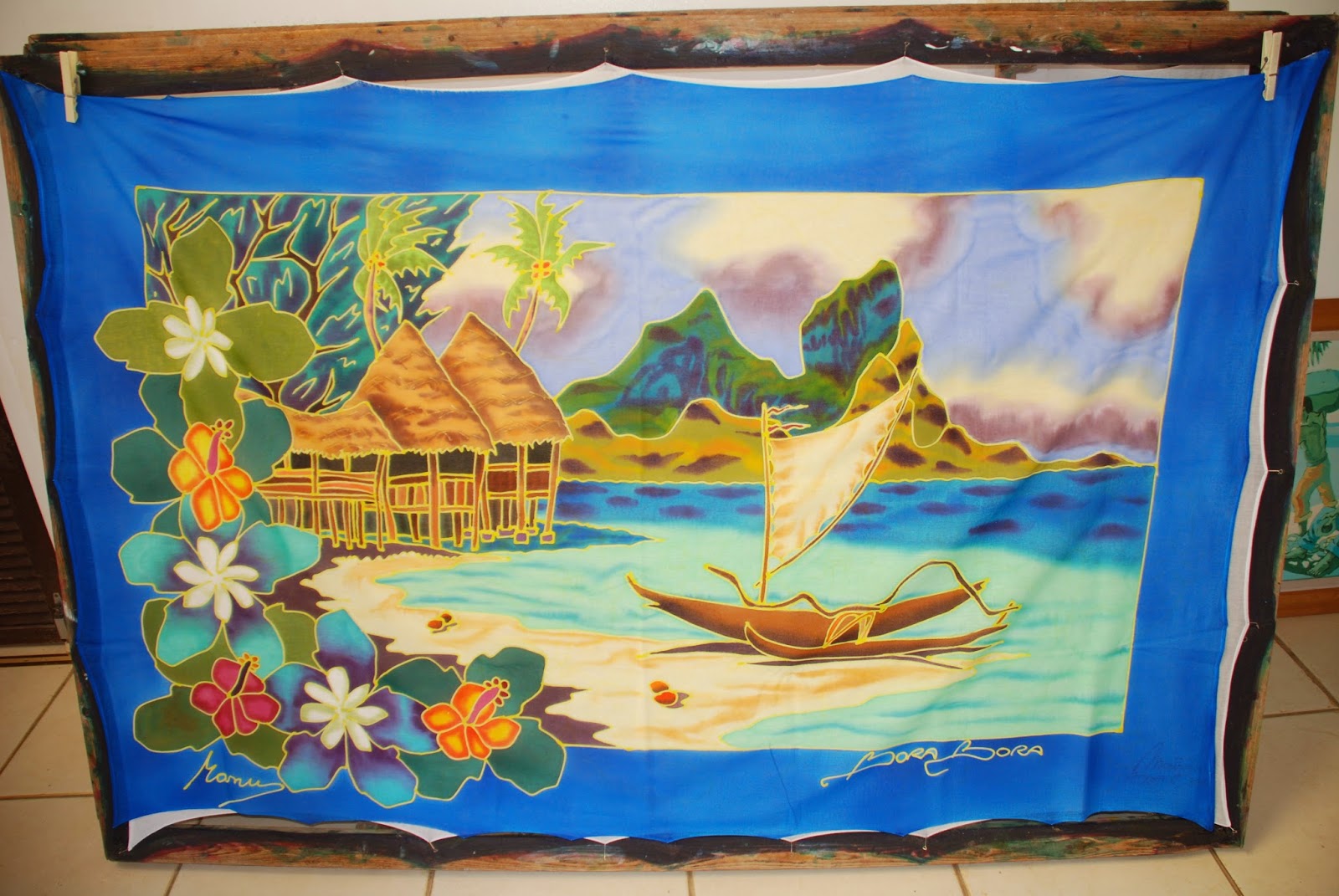 |
| As purchased by James Bond! |
 |
| The artist's front garden... |
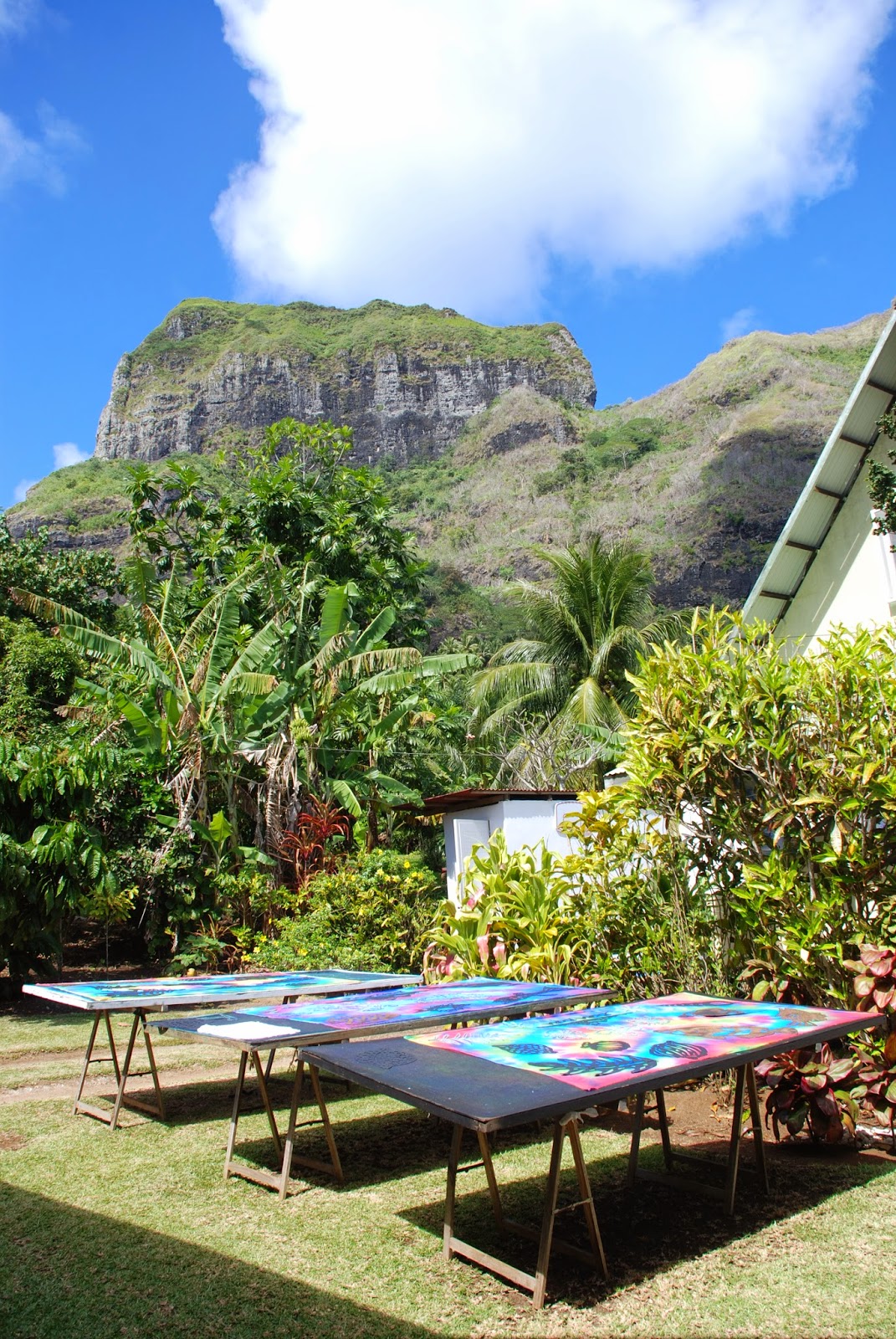 |
| ...and back yard. |
We also asked directions off a lady called Marie who showed us round her large " garden" containing every fruit and vegetable you could think of. She had 3 young children, her husband worked away and this small farm looked a lot of work. Polynesians all love their gardens and work in a symbiotic way with the environment around them to make the whole island beautiful. The practical advantages of growing all your own food does not escape them either.
 |
| Marie's youngest checks out the strangers in her garden |
On the other side of the island, lay a peninsula. You could walk along it to a large rock that looks like a figure of a man,looking out to sea. Legend had it that the mans wife got fed up with him not keeping a proper look out and ignoring her instructions. She got one of the gods to turn him to stone and put him on permanent look out. Just goes to show, -hell hath no fury like a Bora Bora woman scorned!
 |
| Manta Ray reef with the stone man in the foreground |
 |
| The man who got stoned! |
Further along the peninsula lie two well preserved large American Naval guns protecting the bay. The Americans had a major presence in Bora Bora during the pacific war against the Japanese. There were 5000 men stationed on the island. In the concrete base to the gun a marine had inscribed USA May 1942 in the wet concrete.
 |
| American Guns |
 |
| Any Japs out there? |
 |
| Two rusty relics |
The peninsula was also the place where we went snorkelling the next day at 9am to see the giant manta rays cruising up the reef. They were enormous slowly flapping their two wings to glide along the reef. Quite extraordinary.
To get around Bora Bora we hitch hiked which was cheaper and more fun than using a taxi. We met some lovely people who told us how things were on the island. We had noticed a number of graves in peoples gardens. Apparently this is a result of a lack of a municipal cemetery. OK to have your ancestor with you when you live there but a bit of a problem if you want to sell the place. The mayor is under pressure to sort something out.
We went for our final check out of French Polynesia at the Gendarmerie. Watered, provisioned and refuelled in the afternoon. Had a splendid dinner at the Makai yacht club to celebrate one year since our departure from North Wales. Checked the wind GRIB files for the next 6 days and set off for the Cook Islands 600 miles in a South East direction on the morning of 26 july.
Our enduring impressions of the people of French Polynesia was of an intrinsically happy people, who are busy restoring their language and cultural traditions to their rightful place. They are totally non racist and seem to have converted a lot of French people to their way of thinking that you only need to work when necessary, and there's no point accumulating wealth if you have enough to eat. The intermarriage rate with the French is quite high.
The French State now is a relatively benign presence and maintains the islanders happy existence with large injections of cash - long may it continue doing so.
We had intended to call at the Atoll Island of Maupihaa, 135 nautical miles due west of Bora Bora. It is a haven for bird and wildlife. We discovered why the birds have it to themselves the next morning when in a Northerly swell there appeared to be breakers over the approach to the narrow pass. We aborted the approach at the last minute. Poor Colin's shoulder got in the way of a crash jibe, but he's recovered bravely. We spoke to our friend Harry on Malua later. Apparently the Navionics charts for the pass are 300 metres out- a vital difference in a narrow approach. Quite surprising when the electronic charts for the rest of French Polynesia were so accurate.
We then managed to receive an updated GRIB file through the Single Side Band Radio. This is a remarkable machine. Using a computer and modem, we can send a request for weather data for a specified area for the next three days. The request goes to the server run by a non for profit company called sailmail. 10 minutes later we can recontact the nearest radio station and download automatically stored traffic consisting of a digitally compressed graphical picture of the weather with arrows showing wind speeds together with pressure and rainfall. Of course you can only get it when radio propagation is good and you often have to try a few frequencies before you make contact. We can also send and receive short e mails to stay in touch with family. My friend Clive Sparkes installed our system . Even the gismo kid himself was impressed by its ability to make use of old fashioned radiowaves, bounced off the ionosphere , often recievable a couple of thousand miles away. Its much cheaper than a satellite system and the radio has the advantage that you can talk to other yachts on passage on a morning or evening net where you can share information. It's a great boon for single handers to be able to talk over problems.
Anyway the GRIB we received showed very strong winds in the area of Rarotonga , just as we were about to arrive. We spent the next night stooging about, undecided whether to divert to Tonga as most boats were doing, or whether to go to Rarotoga to pick up our mates Richard and Nigel. We decided the next morning when the GRIB files didn't look so bad with a maximum of 30 knot winds in the area. It was great to confirm our decision with our friend Harry from Malua on the radio. Harry is pretty experienced and reckoned we would be OK.
 |
| Harry in Bora Bora before his departure to Tonga. |
As if to confirm our decision, we sailed South in a gentle Northerly breeze on 27 July. We hoisted our newly repaired spinnaker and made 5 knots in 11 knots of wind in lovely sunshine. That evening we arrived at the edge of the low pressure trough and it poured with rain. After dinner the stove collapsed due to a gimbal pin that had fractured. I was not looking forwards to heavy winds with no ability to cook. After ruminating on it overnight the sea was calm in the morning so at 6am I took the stove apart and found a screw top bolt and nuts that would serve as a replacement. Colin and I heaved the stove back into position tightened up the new gimbal and it worked OK. Thank goodness!
On 28 July we made good progress South in a 13 knot South Easterly breeze, we prepared the No2 jib on the inner forestay for the heavy weather we knew was coming. We were quite surprised to loose the wind overnight and have to motor. The calm conditions continued into the morning and then around midday on 29 July, we were hit by an express train in the form of a South Easterly gale. Colin and I struggled onto the foredeck and placed the third reef in the main. It was the worst conditions either of us have been in. The only redeeming feature was that it was warm. We managed to steer downwind a bit got the Aries wind vane working , completely furled the foresail and managed to sail on a beam reach slightly to the east of our destination 185 miles away. As I write this we are now in a full gale gusting over 40 knots of wind with big seas and some breakers hitting the boat. The wind and waves are very noisy. So much for the Grib files. On the positive side we have got a lot of sea room and we are travelling in vaguely the right direction, although the boats head swings through a 60 degree arc. Kika is relatively dry and warm inside , but in these conditions you come to realise just how precarious everything is and I am very thankful we are in a strong boat.
After 18 hours the gale moderated to 25 knots of wind so we could effect damage repair. The stopper knot on the third reef had pulled through preventing the sail from setting right. The mainsail was torn and the lazyjack and flag lines on the starboard side had snapped. One of the lines on the Aries wind vane was down to its inner core. The Aries however had worked brilliantly in very difficult conditions as hand steering would have been exhausting.We cleared away the debris refixed the third reef , hoisted the no2 jib on the inner forestay and got the boat sailing properly again on a close reach at 6 knots with three reefs in the main. Considering the severity of the storm we felt we had got off quite lightly. An event like last night stops you worrying about trivia! Colin and I both admitted to each other afterwards that we were worried men however Sally was never in any doubt that we would be OK!
 |
| Its ripped guv... |
 |
| ...but I know the man for the job! |
Interestingly, we talked to Harry on Malua on the SSB. He is going to Tonga direct but got similar weather and a badly torn mainsail to add to his problems of a malfunctioning engine. He is single handing as his crew Audrey dramatically jumped ship on the day of departure. This involved our Sally who demonstrated traditional British diplomatic skills in dealing with an American and a South African managing to convince Audrey to sign discharge papers down at the gendarmerie . Single handing is fine when things are going well. However when you hit snags, there is no one to talk it over with which is tough and requires a lot of self reliance. Harry seems to be coping well, and made some bread when he was engineless with no wind.
On Wednesday 30 the wind moderated further, the sun made an appearance and we had bedding all over the cockpit to dry out a bit. We should arrive at Rarotonga tomorrow afternoon July 31.
Thursday morning dawned, Colin unreefed the main and we were greeted by the glorious site of Raratoga island and its many peaks wreathed in sunshine and a large condensation cloud
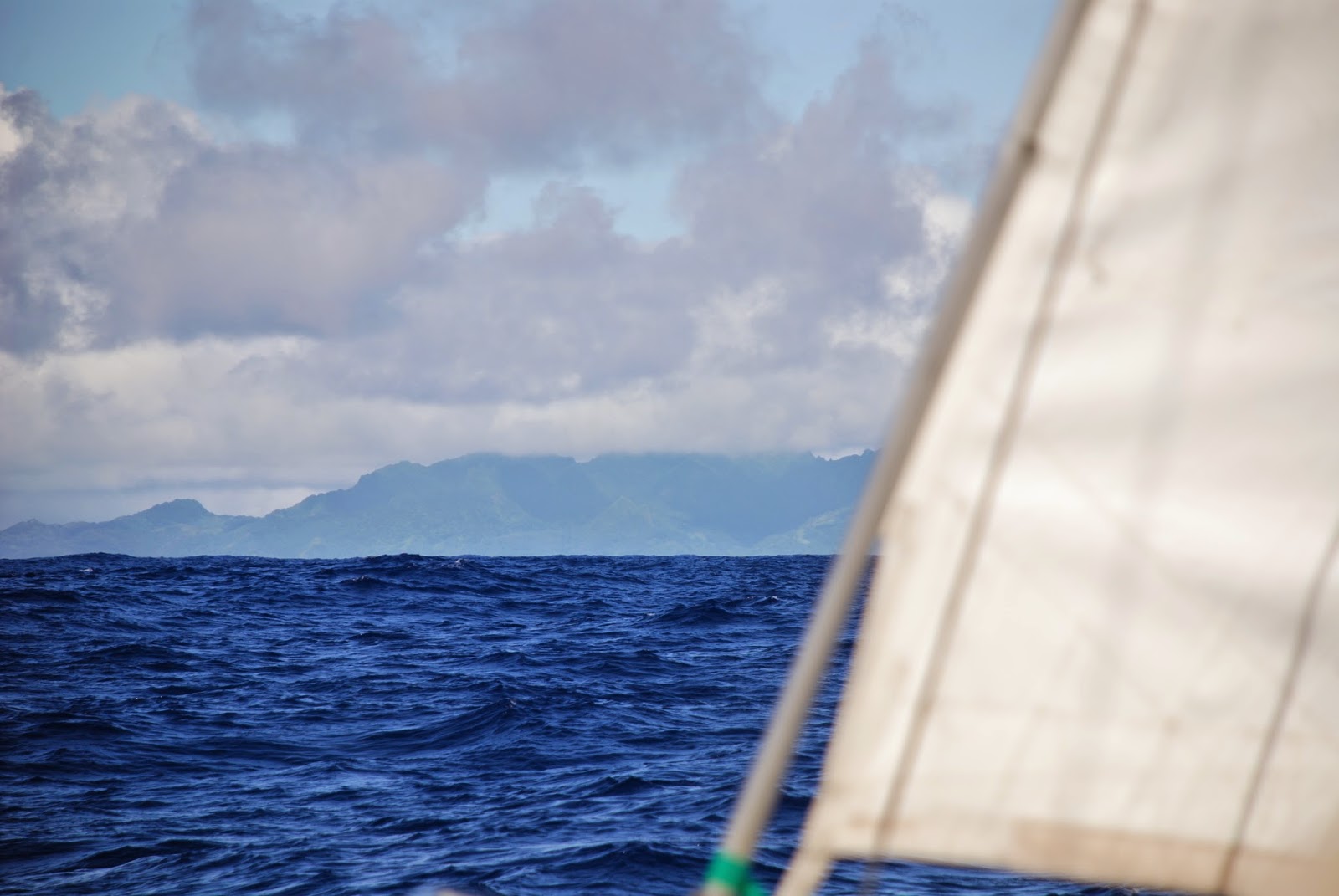 |
| Land ahoy ! |
 |
| Checking the theory after heavy example of the real thing. |
We headed in at a lickety spit 6.5 knots with an ETA of 2 pm.
Just as we approached Avatiu Harbour in Rarotonga , another weather system came in. We backed into a berth between a ship and two contiki like Catamarans. It was tricky. One line broke under the strain. We required multiple shore lines and 50 metres of anchor chain motored out in the dinghy by Colin and Sally to hold kika in position off the dock while the wind howled and torrential rain came in.
We retired into the warmth of the cabin only to discover the loo was blocked. Colin and I had 2 goes at clearing it. The main problem was a build up of uric acid scale on the outlet valve. We eventually got it sorted and Sally had the full luxury cruising experience of unusual odours and the noise of two men cussing and swearing in the heads, while she tried to type up my short story. She gets an award for extreme typing first in a Force 9 Gale and then in a sewage depot.
My shoulder ached badly, but the main thing was that we were warm and safe and out of 35 knot winds out at sea, and lying in the friendly Cook Islands.
 |
| Kika, shaken but not stirred. Grateful to be at rest in Avatui Harbour, Rarotonga. |